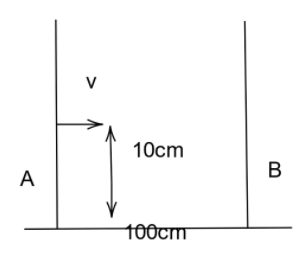
Two paper screens \[A\] and \[B\] are separated by a distance of \[100m\] . A bullet pierces \[A\] and then \[B\] . The hole in \[B\] is \[10cm\] below the hole in \[A\] . If the bullet is traveling horizontally at the time of hitting the screen \[A\] , calculate the velocity of the bullet when it hits the screen \[A\] . Neglect the resistance of paper and air.


Answer
486k+ views
Hint: We start by recording the given values and writing down the equations of motion. We find the value of time of motion and with the help of the value of time of motion, we use another equation of motion and find the value of the final velocity of the bullet.
Formulas used: Equation of motion, \[h = ut + \dfrac{1}{2}a{t^2}\] and \[x = vt\]
Where, \[u\] is the initial velocity of the bullet (which is zero)
\[t\] is the time taken for the motion to happen
\[a\] is the acceleration related to the motion (here it is the acceleration due to gravity)
\[v\] is the final velocity of the bullet.
Complete step by step solution:
Let us start by gathering the given information
Distance between the screens,\[x = 100cm\]
The distance between the holes in the screens, \[h = 10cm\]
We use the equation of motion to find the time of this motion.
\[h = ut + \dfrac{1}{2}a{t^2}\]
The value of initial velocity is taken as zero and so the first term of the equation vanishes and we arrive at, \[h = \dfrac{1}{2}a{t^2}\]
We take the known values to one side and find the value of time of the motion using, \[t = \sqrt {\dfrac{{2h}}{a}} \]
Here, the value of acceleration will be equal to the value of acceleration due to gravity. We take \[10\] instead of \[9.8\] for easier calculation.\[t = \sqrt {\dfrac{{2 \times 0.10}}{{10}}} = 0.14s\]
We have the value of time of the motion. Now we move onto find the final velocity, this can be found using another equation of motion
\[x = vt\]
Separating the known values to one side and substituting, we get \[v = \dfrac{x}{t} = \dfrac{{100}}{{0.14}} = 707.11m/s\]
The final velocity of the motion will be \[707.11m/s\]
Note:
Initial velocity is taken zero because the bullet is initially at rest. The conversion of centimeters to meters must be done or we will end up getting a different solution.
Formulas used: Equation of motion, \[h = ut + \dfrac{1}{2}a{t^2}\] and \[x = vt\]
Where, \[u\] is the initial velocity of the bullet (which is zero)
\[t\] is the time taken for the motion to happen
\[a\] is the acceleration related to the motion (here it is the acceleration due to gravity)
\[v\] is the final velocity of the bullet.
Complete step by step solution:
Let us start by gathering the given information
Distance between the screens,\[x = 100cm\]
The distance between the holes in the screens, \[h = 10cm\]
We use the equation of motion to find the time of this motion.
\[h = ut + \dfrac{1}{2}a{t^2}\]
The value of initial velocity is taken as zero and so the first term of the equation vanishes and we arrive at, \[h = \dfrac{1}{2}a{t^2}\]
We take the known values to one side and find the value of time of the motion using, \[t = \sqrt {\dfrac{{2h}}{a}} \]
Here, the value of acceleration will be equal to the value of acceleration due to gravity. We take \[10\] instead of \[9.8\] for easier calculation.\[t = \sqrt {\dfrac{{2 \times 0.10}}{{10}}} = 0.14s\]
We have the value of time of the motion. Now we move onto find the final velocity, this can be found using another equation of motion
\[x = vt\]
Separating the known values to one side and substituting, we get \[v = \dfrac{x}{t} = \dfrac{{100}}{{0.14}} = 707.11m/s\]
The final velocity of the motion will be \[707.11m/s\]
Note:
Initial velocity is taken zero because the bullet is initially at rest. The conversion of centimeters to meters must be done or we will end up getting a different solution.
Recently Updated Pages
Master Class 11 Economics: Engaging Questions & Answers for Success

Master Class 11 English: Engaging Questions & Answers for Success

Master Class 11 Social Science: Engaging Questions & Answers for Success

Master Class 11 Biology: Engaging Questions & Answers for Success

Class 11 Question and Answer - Your Ultimate Solutions Guide

Master Class 11 Business Studies: Engaging Questions & Answers for Success

Trending doubts
What is meant by exothermic and endothermic reactions class 11 chemistry CBSE

10 examples of friction in our daily life

One Metric ton is equal to kg A 10000 B 1000 C 100 class 11 physics CBSE

Difference Between Prokaryotic Cells and Eukaryotic Cells

What are Quantum numbers Explain the quantum number class 11 chemistry CBSE

1 Quintal is equal to a 110 kg b 10 kg c 100kg d 1000 class 11 physics CBSE




